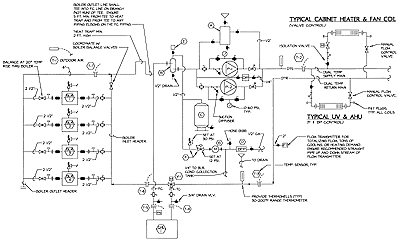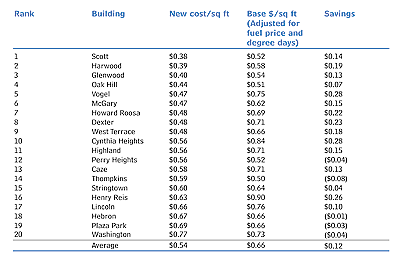
Six years ago, Paul Roberts, director of facilities for the New Albany-Floyd County Schools (New Albany, IN), hired the architect-engineering firm of Veazey, Parrott & Shoulders (VPS, Evansville, IN) to design a two-pipe hvac system for Green Valley Elementary School (New Albany, IN). The conversation went something like this:
VPS - "We gave up on the two-pipe system and idea 30 years ago."
Roberts - "I can't afford anything else."
VPS - "Hmmm. Well, on second thought..."
Wanting the project, the firm realized that age-old problems could become opportunities for creative design. And that's exactly what happened. Innovations from VPS' principal engineer, Thomas H. Durkin, P.E., were coupled with adaptations of existing technology to create a remarkably efficient hvac system - less expensive to build (or retrofit), and less expensive to operate.
With 61 Indiana schools now having the "new-and-improved" two-pipe system in place, Durkin and the respective school districts are finding out that annual savings are huge, even while adding air conditioning to previously non-cooled facilities. At last count - and that was after 38 successful installations - Indiana taxpayers had already saved $10 million in construction costs and $750,000 in annual operating costs thanks to the two-pipe renaissance.
"This two-pipe is redefining conventional wisdom," said Roberts. "Most engineers will tell you two-pipe cannot work, but this system does.
"The question used to be, 'Why are you going to two-pipe?' Now the question should be, 'Why aren't you going to two-pipe?'"

Two-Pipe Background
An engineer has many system options from which to choose when designing a school hvac system. The most common is the four-pipe system, which uses hot water supply and return pipes for space heating (pipes 1 and 2), and chilled-water supply and return pipes for space cooling (pipes 3 and 4).Fifty years ago, an innovative engineer determined that he could save clients money by using the same distribution piping for chilled-water cooling that was used for hot water heating, and changing over from heating to cooling in the spring, then changing back in the fall. This innovation became known as the two-pipe system.
The system died (or at least went into hibernation) because occupant comfort was compromised by numerous problems. The concept of a seasonal changeover didn't work with the cool morning-warm afternoon typical of a spring or fall day.
When the two-pipe system was used, it was mostly on projects facing severe budget limitations.

Nine Solutions To Nine Old Problems
In reviving the concept for modern use, at least nine specific problems of the former two-pipe system were addressed. Let's take a look at each concern, along with the reaction to it within Durkin's strategy.Problem 1: Schools may need heat in the morning and cooling in the afternoon.
Solution 1: The obvious answer is to design a system that can change over as quickly and as often as a school might require.
Problem 2: It takes too long (12 to 24 hrs) to change over from heating to cooling, and vice versa.
Solution 2: Now, control operating parameters and changeover can be done in about 20 min.
Problem 3: It's hard to know when to change over.
Solution 3: Modern digital energy management systems (ems) can monitor all spaces up to several times a minute. The computer decides when it is time to change over and proceeds automatically.
Problem 4: Boilers cannot tolerate cold water when changing over; chillers cannot tolerate hot water when changing over.
Solution 4: In today's market, users can and should negotiate with manufacturers to modify equipment to meet the required service demands.
Problem 5: Too many valves (as many as eight) are associated with the changeover process, a scenario that is both hard to coordinate and maintain.
Solution 5: Durkin designed a schematic with only one changeover valve. Moreover, its heat trap innovation allows isolation of the boilers with no moving parts.
Problem 6: Systems waste energy during changeover.
Solution 6: If you minimize the energy in the loop, the changeover becomes that much more cost-effective.
Problem 7: Parts of the building are still cold when others need cooling.
Solution 7: High-performance windows and insulation make the building much less prone to drafts, and temperatures are thus much more uniform. Also, economizers provide "free" cooling.
Problem 8: Systems tend to overheat in winter.
Solution 8: Decrease your heating water supply temperatures significantly. This not only prevents said overheating, it also saves energy.
Problem 9: Some parts of the building will always be heat positive, such as kitchens and computer rooms.
Solution 9: True. Therefore, separate systems should be provided for those areas.

More Savings
The revised two-pipe system has a significant positive impact on the cost to build schools.A major part of the heating-cooling system installation cost is tied up in distributing energy from wherever it is generated (the mechanical room) to where it is used (the classroom). Among the many system options available, two-pipe is proving to be the least expensive option.
For example, Mount Vernon (IN) Schools asked three firms to perform feasibility studies to air condition three elementary schools totaling 190,000 sq ft. Two of the proposed firms budgeted $2.2 million (four-pipe) and $1.9 million (DX cooling). Durkin and VPS budgeted and installed two-pipe systems in the schools for $1.4 million, helping the schools realize a $500,000 savings on the installation.
Meanwhile, Monroe County (IN) Schools asked three firms to provide feasibility studies to air condition four elementary schools totaling 220,000 sq ft. Two of the proposals estimated $3.9 million (neutral air) and $3.5 million (four-pipe). In this case, Durkin and VPS budgeted and installed two-pipe systems (and upgraded every light in all four facilities) for $2.7 million, realizing a $800,000 savings on the installation. "If it weren't for two-pipe, we could not have afforded to air condition our schools," said Carl Culiver, assistant superintendent of buildings and grounds, Mt. Vernon (IN) Schools.
Bill Wiseheart, supervisor of energy services for New Albany Schools, seems just as impressed with the two-pipe system. "Two-pipe uses digital electronics and creativity to do what other systems do with pumps and piping. It costs a lot less, so more of our money can go to educate the kids."
In a geographical area where the average cost for school utilities is $0.70/sq ft/year, Indiana schools with two-pipe systems are typically operating at $0.50/sq ft/year, with several below $0.40. For instance, the annual utility bills for 20 two-pipe systems in the Evansville-Vanderburgh School Corp. (Evansville, IN) went down an average of $0.12/sq ft. (Figure 1.) This rate drop was accomplished while adding air conditioning to previously non-cooled facilities - realizing a $500,000-per-year savings in operating costs. "Gas consumption at Binford Elementary (Bloomington, IN) went down more than 60%," said Mike Scherer, director of extended services, Monroe County Schools (Bloomington, IN). "The utility company couldn't believe we were saving so much. They changed the gas meter twice."

'Right Tech,' Not High-Tech
From any engineering standpoint, there are six special aspects to the two-pipe design. The first is electronic and speaks to the complexity of the system. Specifically, a sophisticated digital control scheme uses the power of computers to solve the workability issues of the two-pipe system.The remaining factors are mechanical - very straightforward - and are to be admired for their simplicity. Simplicity is the essence of cost savings and maintainability. As Steve Johnston, manager of building and grounds, Evansville (IN) Schools, put it, "Two-pipe is cheaper to build, cheaper to operate, and easier to maintain. What's not to like?"
The first two of these factors are adaptations of existing technologies. These contribute to the exceptional operational economy. One factor includes super-high-efficiency boilers, arranged in a unique schematic (copyrighted by Thomas H. Durkin, 1999) to eliminate all start-up losses and maximize inherent efficiency. The second factor involves two-speed pumps, which equal the efficiency of variable-speed drives (vsd's) at one-quarter the cost.
Two other mechanical factors are innovations. The heat trap isolates the boilers using nature (the differential densities of hot and cold water) and no moving parts requiring maintenance (again, copyrighted by Durkin). Also, fan-speed modulation allows for dehumidification without reheat (another copyright by Durkin).
Helping right along is the Two-Pipe Operators' Group (T-POG). Durkin organized T-POG for continuing education, problem avoidance, and information sharing. Since 1995 the group has met twice annually, with average attendance of 65 people.
The operators learn successful strategies from one another, and they obtain updates on the equipment and refreshers on theory. Durkin and VPS receive feedback on what works and what needs improvement, so that next year's design is even better. There is camaraderie and friendly competition among the various school corporations as they vie for the most efficient building.
The excellent attendance at these meetings speaks to the demand for knowledge among those in whom responsibility for occupant comfort ultimately rests. (In fact, the T-POG homepage has been opened at www.tpog.com so that the operators can stay in touch between meetings.)
In short, everyone benefits. As the T-POG motto states, "None of us are as smart as all of us."
Jeff Taylor, director of facilities for Fayette County (IN) Schools, describes it this way: "It's not high tech. It's not low tech. It's just the right tech."
The Bottom Line: Money Talks
Two-pipe also delivers measurable advantages for the environment. Annual energy savings associated with the 38 installed systems can be expressed as 1,800 tons of carbon dioxide, and 45,000 lb of sulfur dioxide and nitrogen oxide not released into the atmosphere.While not as quantifiable, the improvement of the physical environment in the schools is no less important. In an age in which practically all public facilities are air conditioned (including the newest jail systems), two-pipe systems make school air conditioning more affordable.
Seventy percent of Indiana property taxes are used to pay for building and operating school systems. The "new-and-improved" two-pipe system for these schools has reduced installation costs and dramatically improved the efficiencies of heating-cooling systems.
When compared to other school mechanical systems in the state, the new two-pipe system saves Indiana taxpayers at least:
- 5% of new building construction costs;
- 25% of mechanical system renovation costs; and
- 15% of school annual utility costs.
Even more rewarding, the systems which were retrofitted with air conditioning resulted in lower utility bills than most non-cooled schools.
In summary, the Durkin two-pipe system shows that an idea discarded decades ago may be the future of school heating and cooling. The two-pipe system supports the questioning of assumed truths - of asking the same questions again in the face of new technology and new resources.
The success of the two-pipe projects reveal that cost-effective solutions to many engineering problems may be found by going back to the past, and back to the future. ES

